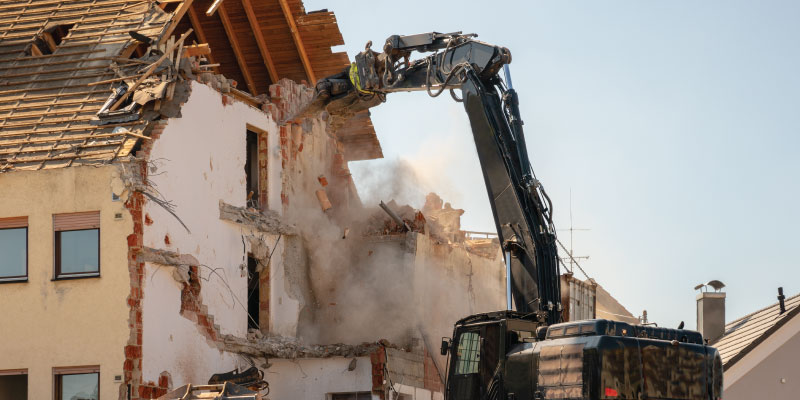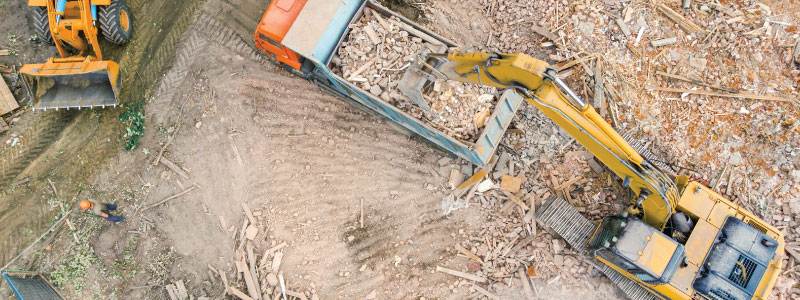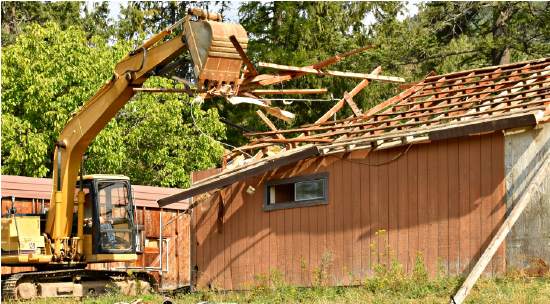
Updated December 8, 2023
A demolition project involves several stages from the initial planning phase to the final completion. Each stage is crucial for the overall success of the project and by following these stages and steps, a demolition project can be effectively planned, executed, and completed with a focus on safety, environmental responsibility, and overall success.
Demolition projects are complex undertakings that require careful planning to ensure safety, efficiency, and a successful outcome. Whether you're demolishing a small structure or undertaking a large-scale project, having a well-thought-out plan is essential.
In this guide, we will walk you through a step-by-step process to help you navigate the intricacies of demolition project planning, so that whether you're demolishing an entire building or a single wall, you'll be prepared.
Demolition Project by Stages:
- Project Planning
- Demolition Plan Development
- Safety & Waste Management Planning
- Equipment & Method Selection
- Communication Planning
- Execution
- Waste Removal & Site Cleanup
- Final Inspections & Documentation
- Project Closure
Find demolition services near you
Project Planning
Step 1: Define the Project Scope and Objectives
Before diving into the details and reaching out to contractors for quotes, we recommend going over your project's objectives, your budget, and the scope of your intended demolition project first. Identify the structures or areas you wish to be demolished, your preferred budget and timeline, and the overall goals of the project. Having a comprehensive understanding of what needs to be accomplished will serve as a foundation for the planning process.
Demolition Plan Development

Step 2: Collaborate with Professionals
Work with structural engineers and demolition contractors to ensure the plan you create not only aligns with your vision but also safety codes and best practices in the industry. Hometown makes it easy to find qualified demolition contractors in your area, request multiple free quotes with the click of a button, read verified customer reviews, and get answers to common demolition questions—all in one place.
Before hiring, we recommend comparing at least three contractors' quotes. This will make it much easier to be sure you're hiring the best company for your project.
Step 3: Conduct a Site Assessment
You and your contractor and/or architect should perform a thorough site assessment to identify any potential hazards, environmental considerations, and regulatory requirements. This includes assessing the presence of hazardous materials, utilities, and neighboring structures. Understanding the site conditions will enable you to develop the best strategy for ensuring you have a safe and efficient demolition.
Step 4: Develop a Demolition Plan
Work with your contractor to develop a detailed demolition plan that outlines the specific methods and techniques to be used. In their plan/estimate, they should include all pertinent details and project factors, like:
- Equipment selection
- Debris disposal
- Necessary permit information (type, costs, who will obtain it, etc.)
- Work schedule and project completion dates
- Payment schedules and accepted forms of payment
- Safety measures that will be taken
Read more: How to Read and Make Sense of a Demolition Estimate
Step 5: Obtain Necessary Permits and Approvals
Check with your contractor and local authorities to determine the required permits and approvals needed for the demolition project. Be sure your contractor complies with building codes, environmental regulations, and safety standards. Obtaining the necessary permissions early in the planning process will prevent delays and complications during the execution phase, as well as headaches in the future.
Find demolition services near me
Safety and Waste Management Planning
Step 6: Establish a Safety Plan
Safety should be a top priority in any demolition project. Develop a comprehensive safety plan that includes protocols for personnel, equipment, and the surrounding environment. Conduct safety training for all personnel involved and ensure that everyone is equipped with the necessary personal protective equipment (PPE).
Step 7: Plan for Waste Management
Develop a waste management plan to handle the debris generated during demolition. Identify recycling opportunities for materials such as concrete, metal, and wood. Proper waste disposal not only contributes to environmental sustainability but also helps manage project costs effectively. Consider recycling demolition debris like concrete, metal, and wood to minimize environmental impact.
Equipment and Method Selection
Step 8: Select the Right Demolition Methods and Equipment
Choose appropriate demolition methods and equipment based on the project requirements and site conditions. Common methods include mechanical demolition, implosion, and deconstruction. The selection of the right equipment, such as excavators, cranes, and wrecking balls, is crucial for the success of the project.
Communication Planning
Step 9: Establish a Communication Plan
Effective communication is essential for the coordination of personnel, equipment, and stakeholders. Develop a communication plan that includes regular updates, progress reports, and contingency measures. Keep all relevant parties informed to maintain a smooth workflow throughout the project.
Execution
Step 10: Monitor and Adjust
Execute the demolition plan while adhering to safety protocols and environmental regulations. Regularly monitor the progress of the demolition project and be prepared to make adjustments as needed. Address any unforeseen challenges promptly and ensure that the project remains on track. Flexibility and adaptability are key to overcoming unexpected obstacles.
Waste Removal and Site Cleanup

Step 11: Clean Up Site
After demolition is complete or at least has begun, the site is assessed, and debris is sorted into recyclable and non-recyclable materials throughout the project or when all the work is done. Recyclable items such as concrete, metal, and wood are often transported to specialized facilities for processing. Non-recyclable and hazardous materials are disposed of in accordance with local regulations, typically through transportation to approved landfills.
Various vehicles, including dumpsters and trucks, are employed for efficient transportation, and heavy equipment such as loaders and excavators may be used during site cleanup. Throughout the process, environmental compliance is paramount, with a focus on ensuring that the disposal methods align with safety standards and regulatory requirements. Proper documentation of the debris removal process, including receipts and records, is maintained for transparency and regulatory adherence. The end goal is to leave the site clear, safe, and ready for any future construction or development activities.
Read more: Clean Up Your Construction Debris Fast with Local Disposal Services
Final Inspections and Documentation
Step 12: Inspect Site and Gather Documents
During the final inspection phase of a demolition project, the site undergoes a comprehensive assessment to ensure that all aspects of the demolition process meet safety, environmental, and regulatory standards. Trained inspectors evaluate the thoroughness of the debris removal, the effectiveness of safety measures, and the overall condition of the site. They verify that all hazardous materials have been properly handled and disposed of, and that the site is free from potential safety hazards. The inspection aims to confirm that the project aligns with the approved demolition plan and adheres to permits and regulations.
Successful completion of the final inspection signifies that the demolition project has been executed in accordance with established guidelines, providing assurance that the site is cleared and safe for subsequent use or development. You should also be sure to compile any and all pertinent documentation, including inspection reports, permits, and other relevant records that you may need to reference in the future.
Project Closure
Step 13: Execute Closeout Procedures
Closeout procedures for a demolition project involve the final administrative tasks and documentation necessary to officially conclude the project. This phase encompasses the closure of permits, contracts, and any remaining contractual obligations. Project managers ensure that all relevant paperwork, including inspection reports, permits, and documentation related to debris removal and waste disposal, is in order and filed appropriately.
Administrative closure signifies the formal completion of the project and may involve the release of any remaining retainage, final payments to contractors, and the transfer of project-related documents to the appropriate stakeholders. The closeout phase ensures that the project's administrative aspects are wrapped up, providing a clear conclusion to the demolition endeavor.
Find demolition services near you
In Conclusion
Demolition project planning is a meticulous process that requires attention to detail and a commitment to safety. By following this step-by-step guide, you can lay the groundwork for a successful demolition project. From defining project objectives to implementing safety measures and waste management strategies, each step plays a crucial role in ensuring the efficient and safe execution of the project. With careful planning and execution, your demolition project can achieve its goals while minimizing risks and environmental impact.


